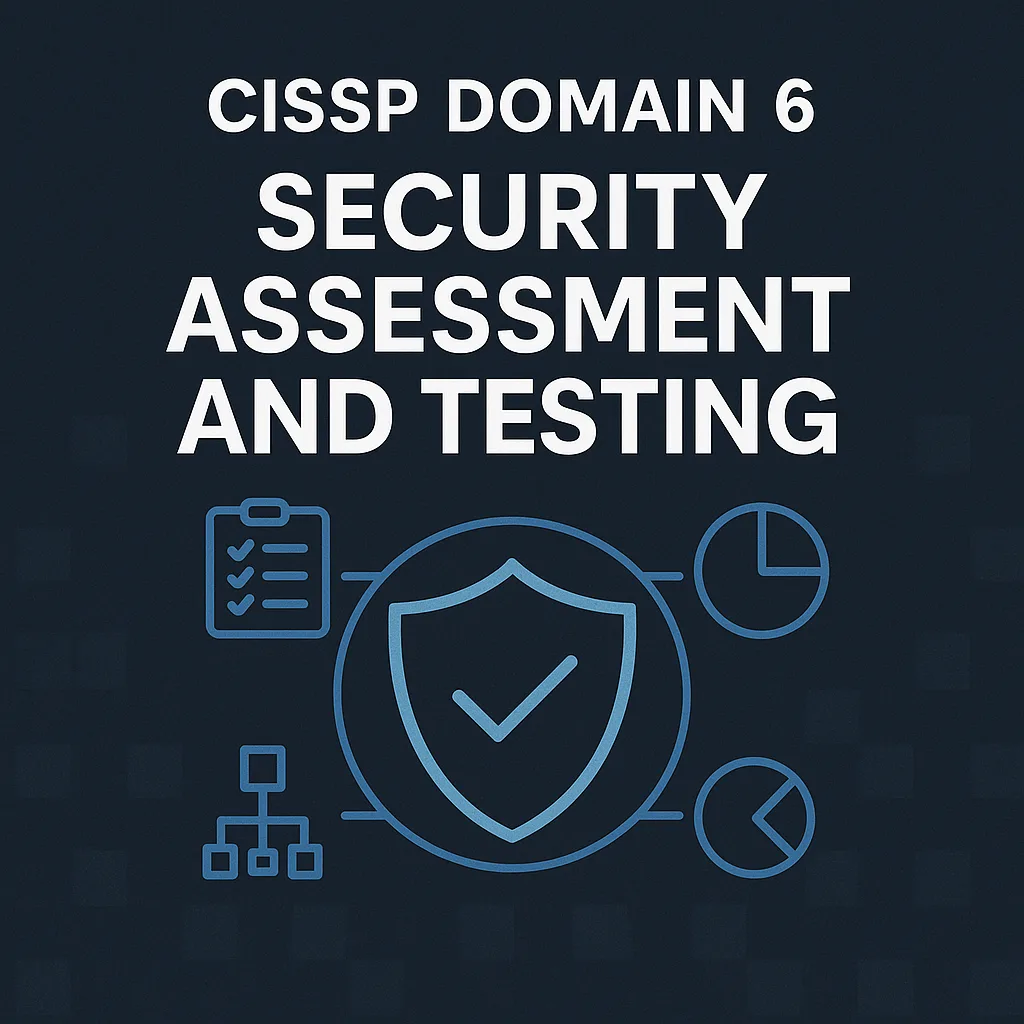CISSP Domain 6: Security Assessment and Testing focuses on the strategies and tools used to evaluate the effectiveness of security controls. It’s essential to ensure that policies, procedures, and controls are functioning as intended and that the organization’s security posture is aligned with its risk appetite.
This domain equips security professionals with the knowledge to plan, execute, and manage audits, assessments, and testing activities that identify weaknesses before they can be exploited.
Core Concepts in CISSP Domain 6
1. Designing and Validating Assessment Strategies
Security assessments must be tailored to the organization’s risk profile and compliance obligations. Key tasks include:
- Defining objectives: What is being tested and why?
- Selecting tools and methods: Based on risk, environment, and required depth.
- Establishing baselines: Comparison to normal or expected performance.
Validation ensures that testing procedures provide accurate and useful results.
2. Security Testing Techniques
Security testing encompasses a variety of methods to evaluate the effectiveness of security mechanisms:
- Vulnerability Scans:
- Automated tools to identify known vulnerabilities (e.g., Nessus, OpenVAS).
- Should be conducted regularly, ideally with credentialed scans for accuracy.
- Penetration Testing:
- Simulates real-world attacks to uncover exploitable weaknesses.
- Includes phases: planning, reconnaissance, exploitation, reporting.
- Can be black-box (no info), white-box (full info), or gray-box.
- Security Audits:
- Formal reviews of security policies, procedures, and configurations.
- Ensure compliance with standards (e.g., ISO 27001, PCI-DSS, NIST).
- Code Review:
- Manual or automated inspection of source code for vulnerabilities.
- Looks for insecure functions, buffer overflows, logic flaws.
- Log Reviews and Monitoring:
- Review system, application, and security logs for anomalies and indicators of compromise (IOCs).
3. Conducting Security Control Testing
Controls must be tested regularly to verify their ongoing effectiveness:
- Manual Testing: Includes interviews, observations, and walkthroughs.
- Automated Testing: Tools that evaluate configurations, access rights, and compliance.
- Control Effectiveness Reviews:
- Preventive (e.g., firewall rules)
- Detective (e.g., IDS alerts)
- Corrective (e.g., patching workflows)
Testing should cover administrative, technical, and physical controls.
4. Collecting and Managing Security Metrics
Metrics provide insight into control performance and guide decision-making:
- Quantitative Metrics: Measurable data such as “failed logins per week.”
- Qualitative Metrics: Subjective assessments (e.g., control maturity level).
- Key Performance Indicators (KPIs) and Key Risk Indicators (KRIs): Track performance and exposure.
Effective metrics are:
- Relevant
- Actionable
- Time-bound
5. Facilitating Security Audits
Security professionals often support or manage audits, which may be:
- Internal: Conducted by internal teams for self-assessment.
- External: Performed by third-party auditors for regulatory compliance.
Audit roles include:
- Auditee: Provides documentation and answers inquiries.
- Auditor: Evaluates controls against criteria.
- Security Officer: Ensures coordination and remediation.
Understanding how to prepare for and respond to audit findings is critical.
6. Test Outputs and Remediation
After testing, reports should include:
- Summary of findings
- Severity ratings
- Risk implications
- Recommended remediation
Following up with a remediation plan ensures vulnerabilities are mitigated within defined timelines.
Why Domain 6 Matters
Without regular security assessments and testing, controls may become outdated, misconfigured, or bypassed. Proactive testing:
- Detects vulnerabilities before attackers do
- Ensures compliance with laws and frameworks
- Supports risk-based security decision-making
- Drives continuous improvement in security posture
Conclusion
CISSP Domain 6: Security Assessment and Testing provides the methodologies and tools needed to evaluate and enhance an organization’s security effectiveness. Mastery of this domain ensures that vulnerabilities are identified early, controls remain effective, and systems stay resilient against evolving threats.


